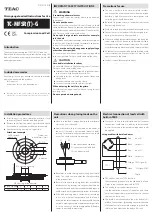
D01211801B
Z
Strain gauge load cell Instructions for Use
TC-MFSR(T)-G
Compression Load Cell
Introduction
Thank you for purchasing the TC-MFSR(T)-G load cell.
Please read this document completely before using this
load cell to achieve its best performance and ensure safe
and proper operation.
Included accessories
If anything is missing or damaged, contact the retailer
where you purchased the product.
Test report × 1
Instructions for Use (this document) × 1
o
Company names and product names in this document are the
trademarks or registered trademarks of their respective owners.
IMPORTANT SAFETY INSTRUCTIONS
V
WARNING
If something abnormal occurs
Request repair from the retailer where you purchased
the product.
Do not open the cover.
Never remove the cover from this unit. Doing so could
cause malfunction. Request inspection and repair from the
retailer where you purchased the product. Do not alter this
unit. Doing so could cause malfunction.
Do not put foreign objects or water, for example,
into the unit.
Do not place a container that holds water, for example, on
top of this unit. If liquid is spilled, for example, and enters
the unit, this could cause malfunction.
Do not use the unit with any power supply voltage
other than that specified.
Do not use the unit with any power supply voltage other
than that specified. Doing so could cause malfunction.
V
CAUTION
Unsuitable installation locations
Do not place the unit in the following types of locations.
Doing so could cause malfunction.
o
Locations where it might be exposed to smoke or steam,
such as near a kitchen table or humidifier
o
Unstable locations, including unsteady stands and
tilted places
o
Locations that are very humid or dusty
o
Locations that are exposed to direct sunlight
When not using the unit for a long time
For safety, cut the power supply when not using this unit
for a long time.
Do not operate a damaged unit.
Precautions for use
o
This unit is not built to be water or splash resistant,
and it cannot be used in conditions when the relative
humidity is high. Moreover, use in atmospheres with
corrosive gases should be avoided.
o
Be careful to prevent water, oil and other substances
from getting on the unit.
o
Avoid use in conditions where condensation could occur.
o
Connect cores to the load cell after discharging (elim-
inating) static electricity from your body.
o
If the surrounding temperature changes suddenly, the
values output by this device could become unstable,
making accurate measurement impossible. (This could
occur, for example, in a location blown by warm or cold air.)
o
If a cable of this unit needs to be bent and shifted, make
the curvature of the bent part at least 20 mm. Do not
apply tension to the cable.
o
Conduct load calibrations periodically.
Installation procedures
o
Install this unit in a place where the structure is level
and can sufficiently bear the load being used.
o
Remove any oil from the mounting surface and attach
it with double-sided tape or adhesive, for example.
o
Attachment using housing is also possible.
Attachment example
Dimensions
in millimeters (mm)
4x Ø2.2 attach-
ment holes
P.C.D: D
E: Slot
dimension
Thick
ness: C
ØA: Housing opening
ØB: Housing inside diameter
Rated capacity
A
B
C
D
E
20 N, 50 N
10
12.5
0.5
19
2.5
Precautions when placing loads on the
unit
o
Make sure the load is perpendicular to the surface to
which this unit is attached.
o
Apply the load so that it is centered on the center of
the unit. If the load is not centered (eccentric load),
twisting, for example, and measurement errors could
occur. This could even result in damage.
F1
F2
F
F is the correct load orientation
F1 is an eccentric inclined load
F2 is an eccentric load
o
Be careful to avoid turning and twisting from lateral
loads. This could cause troubles like those described
in the previous item.
o
Be careful to avoid applying loads that exceed the
rated capacity. In particular, use caution when there are
vibrations because loads that exceed the rated capacity
could occur due to sympathetic vibrations, for example.
o
If the load receiving area is contacted by something
that is at a different temperature and the load is
increased, the values output by this device could become
unstable, making accurate measurement impossible.
In such a case, wait until the temperature difference
ceases to exist before measuring.
Electrical connection of load cell with
built-in TEDS
o
Connect as shown in the illustration below. Incorrect
connections could result in inability to balance and
in errors occurring in the output voltage when loads
are applied.
Using a cable with bare lead wires
Red
Input (+)
Black
Output (−)
Blue
Input (−)
White Output (+)
Orange TEDS signal (+)
Green TEDS signal (COM)
Shield
TEDS
o
This unit has a built-in TEDS function.
The orange and green cores in the cable and the F and
G pins in the connector are wired for TEDS.
o
This unit does not support remote sense.
See the operation manuals of indicators and strain
amps that support remote sense for how to connect
sensors with those units.
o
The shield is not connected to the main body of this
product. For this reason, if grounding is necessary because
of external noise, for example, arrange to ground the
shield to a part other than the body of this unit.




















